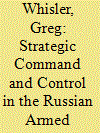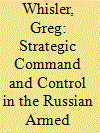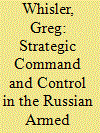|
|
|
Sort Order |
|
|
|
Items / Page
|
|
|
|
|
|
|
| Srl | Item |
| 1 |
ID:
170486


|
|
|
|
|
| Summary/Abstract |
This article is the first in a series of three that examines the Russian Armed Forces’ efforts to adjust their strategic command and control architecture in the post-Soviet period, taking into account wide-ranging shifts in force structure, missions, geography, resources, and leadership. From 1996 to 2000, changes reflected Russian military reform more broadly: much conceptualization, but little implementation. In the first four years of Putin’s presidency, the military leadership advocated strategic command and control reforms, but remained focused on more fundamental issues of military readiness, service conditions, and downsizing. More wide-ranging changes began in earnest in the mid-2000s, only to be overtaken by an even more fundamental defense reform process initiated in 2007. The process of changing the strategic C2 system captured many political, cultural, and strategic facets of post-Soviet Russian military development.
|
|
|
|
|
|
|
|
|
|
|
|
|
|
|
|
| 2 |
ID:
171682


|
|
|
|
|
| Summary/Abstract |
This article is the second in a series of three that examines the Russian Armed Forces’ efforts to adjust its strategic command and control architecture in the post-Soviet period, taking into account wide-ranging shifts in force structure, missions, geography, resources, and leadership. From 2007 through late 2012, the Russian military was gripped with sweeping, painful, and controversial reforms implemented by Defense Minister Anatoliy Serdyukov and Chief of the General Staff Nikolay Makarov. Among many drastic changes, Serdyukov and particularly Makarov finally re-apportioned strategic C2 responsibilities between the General Staff, military districts, and service Main Commands. The latter were relegated largely to ‘train and equip’ roles, while the military districts became truly ‘joint’ commands, and the General Staff became the authority for all operational and strategic planning. The reforms were nascent by the time of abrupt military leadership changes in late 2012 and were not without flaws, but they were a critical breakthrough that simplified and rationalized roles and responsibilities at the highest levels of the Russian military.
|
|
|
|
|
|
|
|
|
|
|
|
|
|
|
|
| 3 |
ID:
173245


|
|
|
|
|
| Summary/Abstract |
This article is the final in a series of three that examines the Russian Armed Forces’ efforts to adjust its strategic command and control architecture in the post-Soviet period, taking into account wide-ranging shifts in force structure, missions, geography, resources, and leadership. President Vladimir Putin somewhat abruptly installed a new leadership tandem at the Ministry of Defense in late 2012, prompting a backlash against the wrenching defense reforms of the preceding four years. The new strategic command and control system established during the reforms came under scrutiny, but Russian military leaders ultimately determined that with some relatively minor adjustments, the system was ideal. This relatively flat and well-organized strategic command and control system has already demonstrated its effectiveness in Ukraine and Syria. More broadly, the 20-year process of forming this system was one of the most important facets of Russia’s post-Soviet defense reform process and probably the most successful.
|
|
|
|
|
|
|
|
|
|
|
|
|
|
|
|
|
|
|
|
|